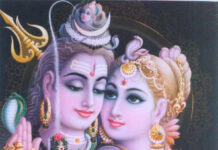Emotions are collective forces, not just our own personal reactions. For example, anger is much like fire. There is ultimately no “my anger” or “your anger”, there is just anger. When you are angry, it is not your anger, but anger is expressing itself through you.
By David Frawley
The anger you feel is the same as the anger anyone else feels, extending to the animal kingdom. During the time you are angry there is no real self-awareness but just a collective force of nature at work. It may have some necessity in situations of real danger, but is usually a social reaction that leads us into further conflict, and becomes embedded in the psyche as a conditioned response.
This is why when a negative emotion dominates us, we do things that otherwise we would find to be irrational or wrong. Our better judgement gets disrupted by these powerful collective forces. Just as anger, the same is true of fear, desire, envy, jealousy, greed, or any other disturbed emotion. The turbulent emotion demands satisfaction through immediate action, but one that is based upon compulsion not consciousness. So emotional reactions lead us into errors, wrong actions, conflict and sorrow, and we often come to regret them.
Emotions easily become collective forces in society, as we see in social moods, trends, crowd reactions or mob violence, in which individuals will do in a group would do things they never would do on their own. The most severe manifestation comes in the form of war, in which entire countries can be consumed by anger or fear. The current global pandemic, given its danger to our lives, gives rise to many turbulent emotions that can make responsible action difficult, extending to panic that paralyzes us. Even if we are right in the sense that our anger may be justified, the anger or any other disturbed emotion does not produce the clarity of mind necessary to properly deal with difficult situations.
WAYS TO CALM EMOTIONAL DISTURBANCES
How then do we calm our disturbed emotions? It is not easy and requires that we cultivate our awareness overall. First you must realize that these disturbed emotions are not yours. They are forces clouding your mind and driving your prana from outside your control, emotional toxins as it were. We must learn to observe and witness our emotions from the standpoint of the Seer, the Self within. This in turn requires that we observe and witness our own minds during the day, including during waking, dream and deep sleep. When our awareness is detached from our emotions, emotions naturally disperse like clouds in the sky. Then we have a psychological immunity from negative emotions invading or taking over our mind sphere.
An attentive introspective and contemplative awareness does not easily fall into emotional reactions. But since emotion is a deep-seated instinctual pranic reaction, it is very difficult to control it altogether. We must cultivate moment by moment awareness to do this. The mind and its thought process cannot do this, as thought easily yields to emotion.
The media, whether mainstream or social, can quickly promote or spread emotions, positive or negative, but usually prefers the negative, which is more dramatic. We can see this in the fear and anger in our news and in our entertainment. We often enjoy watching other people in states of duress, even life-threatening danger. The pandemic has made fear, anger, despair and desperation in distance parts of the world part of our daily emotional involvements.
POSITIVE EMOTIONS AND UNITARY FEELINGS
Some may ask whether there are positive emotions and if we can use them to counter negative emotions. This is another option common in yogic circles, but it is better to call positive emotions as positive feelings. Negative emotions arise from the ego and self-protective mechanisms. Positive feelings come from the non-ego as love, devotion, compassion and fearlessness. They are not compulsive reactions but the expressions of a deeper awareness that is independent of external influences and universal in its orientation. We must move from divisive emotions to unitary feelings, oneness in manifestation.
To counter emotional negativity, we must learn the art of wishing the best for everyone, affirming happiness and freedom of suffering for all, even those whom we disagree with and we may be opposed to. We this in Vedic chants for peace and happiness for all beings and for the entire universe. We must affirm the universality of the feeling of interconnectedness to counter emotional compulsions and addictions.
Yet we must also be willing to let our negative emotions go, however justified we may think they are. We should not let an emotional residue cloud our minds. We must discern what is right or wrong, dharmic or adharmic, but maintain the clarity of mind and the compassion necessary to act with wisdom.
We need to purify our minds of negative emotions in order to deeply meditate. This occurs when we recognize our disturbed emotions as powers of ignorance that we fall into from lack of self-discipline and self-awareness, and cultivate the inner light to naturally disperse them. This process is called purification of the mind (Chitta Shuddhi or Chitta Prasadhana) in Sanskrit), an important topic of Yoga and Vedanta, most known in the Yamas and Niyamas of the Yoga Sutras. Cultivating peace, contentment, clarity, respect , compassion and devotion, and honoring the sacred in all being helps us move beyond all mental darkness. Mantra and Pranayama are also very helpful.
Your own inmost consciousness is pure, happy, compassionate and kind by nature, but to find and abide in it, we must learn to let go of the unconscious turbulence that we fall into when our awareness is so externalized we lose connection with our inner peace. Affirm your true Self as Being-Consciousness-Bliss. Awaken and share your inner Ananda. Do not make yourself into a victim of the emotional turbulence of the outer world world.
Om Shanti! Shanti! Shanti!
Article Courtesy : www.vedanet.com












